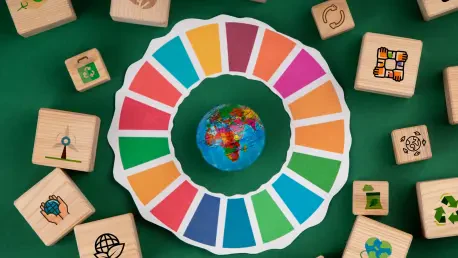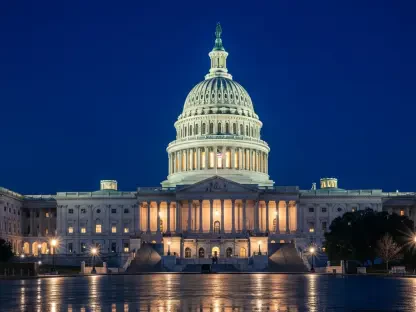Imagine a world where the largest carbon emitter, responsible for over 31% of global carbon dioxide emissions, steps up with a transformative plan to combat climate change, sparking a spectrum of reactions from hope to skepticism across the globe. This is the reality today as China unveils ambitious climate goals, and the stakes couldn’t be higher with escalating environmental crises threatening vulnerable populations and straining international cooperation. This roundup gathers diverse opinions, insights, and critiques from various international voices to explore the implications of China’s pledges, the contrasting stances of other nations, and the urgent need for collective action in a divided landscape.
Exploring China’s Bold Climate Vision
Unpacking the Ambitious Emission Targets
China’s recent climate commitments have captured global attention with a pledge to reduce emissions by 7-10% by 2035. This target represents a significant shift for a nation heavily reliant on coal, signaling an intent to pivot toward a greener economy. The scale of this ambition is underscored by plans for a sixfold increase in wind and solar capacity over the coming decade, alongside a goal to boost non-fossil fuels to over 30% of the energy mix.
Industry observers note that while the targets are impressive on paper, the timeline for implementation raises questions. Transforming an economy of this magnitude involves not just technological upgrades but also systemic overhauls in policy and infrastructure. The challenge lies in balancing economic growth with such aggressive environmental goals, a concern echoed by analysts who point to the entrenched coal dependency.
Some environmental advocates express cautious optimism, highlighting that even partial success could set a powerful precedent for other major emitters. However, there’s a shared concern about accountability mechanisms to ensure these promises translate into measurable outcomes. The global community watches closely, aware that China’s progress could redefine the trajectory of international climate efforts.
Renewable Energy as a Game-Changer
Central to China’s strategy is a massive push for renewable energy, with projections indicating rapid growth in wind and solar sectors. Plans also include widespread adoption of pollution-free vehicles and the development of infrastructure to support a climate-adaptive society. This focus positions China as a potential leader in green technology, with ripple effects for global markets.
Economic analysts suggest that this shift could catalyze innovation and create millions of jobs in renewable industries, offering a blueprint for other nations. Yet, there are warnings about the risks of over-reliance on nascent technologies that may not yet scale effectively. The transition could also disrupt traditional energy sectors, impacting communities dependent on fossil fuel economies.
International energy experts emphasize the opportunity for China to export sustainable solutions, potentially reshaping trade dynamics in green tech. However, they caution that without robust global partnerships, the benefits might be limited to domestic gains. The consensus leans toward viewing this as a high-stakes gamble with transformative potential if executed with precision.
Global Reactions and Calls for Unity
China’s Push for Shared Responsibility
China has not shied away from urging developed nations to take the lead in climate action, subtly critiquing deviations from international agreements like the Paris Accord. This stance has sparked varied responses, with some leaders seeing it as a justified call for historical emitters to bear greater responsibility. Others interpret it as a diplomatic maneuver to deflect scrutiny from domestic challenges.
Comparisons with other regions reveal stark contrasts in approach. The European Union, for instance, points to a nearly 40% reduction in emissions over decades through sustained investments in renewables and carbon pricing mechanisms. This achievement is often cited as evidence that systemic change is possible, though it required consistent political will and economic sacrifice—elements not universally replicable.
Developing nations, on the other hand, appreciate China’s rhetoric as it aligns with their advocacy for equitable burden-sharing. Yet, there’s a lingering fear that such statements might deepen existing tensions with major powers like the United States, where policy divergence on climate issues remains pronounced. The question remains whether this call can foster collaboration or merely widen the rift.
Contrasting National Stances on Climate Urgency
The United States presents a sharp counterpoint, with current leadership expressing skepticism about climate initiatives, even labeling them as economically detrimental. This dismissal, coupled with a decision to withdraw from key global agreements, frustrates many who see American involvement as crucial for momentum. Environmental groups argue that this stance undermines collective progress at a critical juncture.
Meanwhile, voices from South America, particularly Brazil, stress the borderless nature of climate impacts, pointing to natural disasters that spare no nation regardless of military or economic might. This perspective resonates with smaller countries facing immediate threats, advocating for a unified front over fragmented policies. Their plea is for actionable solidarity rather than rhetorical sparring.
Insights from UN representatives highlight a silver lining—global warming projections have improved slightly due to concerted efforts, though the gap to critical targets persists. There’s a strong push for updated national climate plans to reflect current realities, a sentiment shared across regions. This diversity in viewpoints underscores a complex web of priorities, yet a common thread of urgency ties them together.
Human Stories and the Cost of Inaction
Beyond policy debates, the human toll of climate change emerges as a unifying concern, with accounts from nations like Pakistan illustrating devastating flood impacts on millions. These stories, shared by regional leaders, serve as stark reminders of what’s at stake when global action falters. They ground abstract targets in tangible suffering, urging a rethink of isolated approaches.
International humanitarian organizations echo this sentiment, noting that vulnerable populations bear the brunt of delays in climate mitigation. Their reports emphasize the need for adaptive measures alongside emission cuts, a dual strategy often overlooked in high-level discussions. The call is clear: solutions must address immediate crises as much as long-term goals.
Some policy thinkers argue that these narratives could be the catalyst needed to bridge political divides, as they transcend national interests. By focusing on shared humanity, there’s potential to rally support for inclusive frameworks that prioritize both prevention and relief. This human-centered lens offers a compelling argument for why cooperation must override contention.
Key Takeaways from a Divided Climate Arena
Reflecting on this roundup, it’s evident that China’s climate pledges stand as a beacon of ambition amidst a fragmented global response. The stark contrast with the United States’ withdrawal from key agreements highlights deep policy rifts, while regional perspectives from the EU and Brazil showcase alternative paths and universal concerns. The human stories, especially from flood-ravaged areas, bring a visceral urgency to the discourse, reminding all of the real-world consequences.
Looking back, the discussions revealed a shared recognition of the need for updated national plans under global frameworks like the Paris Agreement. Moving forward, actionable steps include bolstering investments in renewable technologies and advocating for policies that ensure equitable responsibility. Nations and individuals alike are encouraged to delve deeper into local climate initiatives, supporting grassroots efforts that complement international goals.
As this conversation unfolds, the path ahead demands innovative partnerships to close the warming gap and protect the most vulnerable. Exploring further resources on national climate strategies or engaging with green tech developments offers a practical way to stay involved. The journey toward sustainability, as evidenced by these diverse insights, requires sustained commitment beyond borders and political divides.









